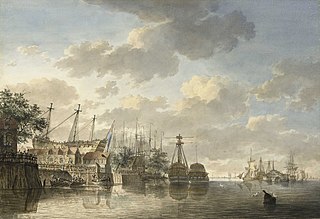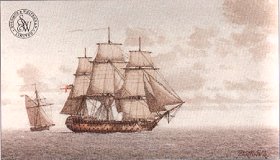HMS Ocean was a 98-gun second-rate ship of the line of the Royal Navy, launched from Woolwich Dockyard on 24 October 1805. She was the only ship built to her draught, and designed by Sir John Henslow.

HMS Duke of Wellington was a 131-gun first-rate ship of the line of the Royal Navy. Launched in 1852, she was symptomatic of an era of rapid technological change in the navy, being powered both by sail and steam. An early steam-powered ship, she was still fitted with towering masts and trim square-set yards, and was the flagship of Sir Charles Napier.

HMS Ganges was an 84-gun second-rate ship of the line of the Royal Navy, launched on 10 November 1821 at Bombay Dockyard, constructed from teak. She was the last sailing ship of the Navy to serve as a flagship, and was the second ship to bear the name.

HMS Queen was a three-deck 90-gun second-rate ship of the line of the Royal Navy, launched on 18 September 1769 at Woolwich Dockyard. She was designed by William Bateley, and was the only ship built to her draught. Her armament was increased to 98 guns in the 1780s.

HMS Queen was a 110-gun first-rate ship of the line of the Royal Navy, launched on 15 May 1839 at Portsmouth. She was the last purely sailing-built battleship to be ordered. Subsequent ones were ordered with both sails and steam engines. All British battleships were constructed with sailing rig until the 1870s. HMS Queen had an auxiliary steam engine fitted in late 1850s. She was broken up in 1871.

HMS Royal Sovereign was a 100-gun first-rate ship of the line of the Royal Navy, which served as the flagship of Admiral Collingwood at the Battle of Trafalgar. She was the third of seven Royal Navy ships to bear the name. She was launched at Plymouth Dockyard on 11 September 1786, at a cost of £67,458, and was the only ship built to her design. Because of the high number of Northumbrians on board the crew were known as the Tars of the Tyne.

Sir Thomas Slade was an English naval architect best known for designing the Royal Navy warship HMS Victory, which served as Lord Nelson's flagship at the Battle of Trafalgar in 1805.

HMS Britannia was a 120-gun first-rate ship-of-the-line of the Royal Navy, laid down in 1813 and launched on 20 October 1820.

HMS Edgar was a 74-gun third-rate ship of the line of the Royal Navy, that saw service in the American Revolutionary, French Revolutionary and Napoleonic Wars. Launched in 1779, she fought in the battles of Cape St Vincent and Copenhagen, two of the major naval engagements of the wars.

The Caledonia-class ships of the line were a class of nine 120-gun first rates, designed for the Royal Navy by Sir William Rule. A tenth ship was ordered on 29 October 1827 to the same design, but was launched in 1833 as Queen to a fresh design by Sir William Symonds.

HMS Nelson was a 126-gun first rate ship of the line of the Royal Navy, launched on 4 July 1814 at Woolwich Dockyard, but then laid up incomplete at Portsmouth until 1854, when work began with a view to commissioning her for service in the Crimean War, but this ended before much work had been done, and the ship returned to reserve.

HMS St Vincent was a 120-gun first-rate ship of the line of the Royal Navy, laid down in 1810 at Devonport Dockyard and launched on 11 March 1815. She saw service at sea in the mid 19th century before becoming a training ship in Portsmouth Harbour until she was decommissioned in 1906.

HMS Blenheim was a 74-gun third rate ship of the line of the Royal Navy, launched on 31 May 1813 at Deptford Dockyard.

HMS Royal Charles was a 100-gun first-rate ship of the line of the Royal Navy, designed and built by Sir Anthony Deane at Portsmouth Dockyard, where she was launched and completed by his successor as Master Shipwright, Daniel Furzer, in March 1673. She was one of only three Royal Navy ships to be equipped with the Rupertinoe naval gun.

HMS Rodney was a two-deck 90-gun second-rate ship of the line of the Royal Navy. Launched in 1833, she was broken up in 1884.

HMS Nile was a two-deck 90-gun second-rate ship of the line of the Royal Navy, launched on 28 June 1839 at Plymouth Dockyard. She was named to commemorate the Battle of the Nile in 1798. After service in the Baltic Sea and the North America and West Indies Station, she was converted to a training ship and renamed HMS Conway, surviving in that role until 1953.

HMS Cumberland was a 70-gun third rate ship of the line of the Royal Navy, launched on 21 October 1842 at Chatham Dockyard. She carried a crew of 620 men.

HMS Terrible was when designed the largest steam-powered wooden paddle wheel frigate built for the Royal Navy.

Deptford Dockyard was an important naval dockyard and base at Deptford on the River Thames, operated by the Royal Navy from the sixteenth to the nineteenth centuries. It built and maintained warships for 350 years, and many significant events and ships have been associated with it.

HMS Victory is a 104-gun first-rate wooden sailing ship of the line. With 247 years of service as of 2025, she is the world's oldest naval vessel still in commission. She was ordered for the Royal Navy in 1758, during the Seven Years' War and laid down in 1759. That year saw British victories at Quebec, Minden, Lagos and Quiberon Bay and these may have influenced the choice of name when it was selected in October the following year. In particular, the action in Quiberon Bay had a profound effect on the course of the war; severely weakening the French Navy and shifting its focus away from the sea. There was therefore no urgency to complete the ship and the signing of the Treaty of Paris in February 1763, meant that when Victory was finally floated out in 1765, she was placed in ordinary. Her construction had taken 6,000 trees, 90% of them oak.






















